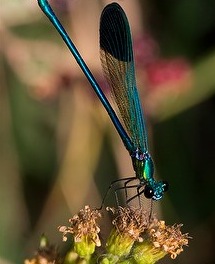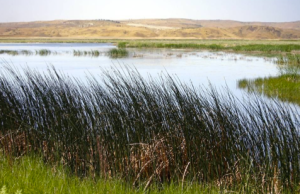In biblical accounts, the Jordan River Valley is closely associated with a healthy, lush and functioning ecosystem. Today, the River’s trickling water and disappearance of more than half of its species are hardly in-keeping with this image. But who keeps an eye on the disappearance of the River’s species? We welcome a founding member of Friends of the Earth Middle East, in the Amman office, who has devoted the last 25 years to conservation efforts in the Jordan Valley.
Photo credits: Shai Pilosof
The “Syrian Demoiselle” (Calopteryx syriaca) is a Damesfly which used to be widespread along the Jordan’s shores. Today it can only be found in a few sites of the Rivers’ banks.
Adnan, FoEME, and biodiversity. Adnan Budieri’s interest in ecosystems and aquatic life goes back to his childhood next to the sea. His early fascination for the sea, fish and corrals brought him to wetland conservation and marine biology studies. Working as the head of research survey for the Jordanian Royal Society for the Conservation of Nature (RSCN), Adnan met with Israeli and Palestinian environmentalists in Taba 1994. It was this first meeting, and the will to put in place an enduring structure as opposed to another ephemeral project, that gave birth to Ecopeace, later to be called Friends of the Earth Middle East.
After working as the Regional Director of Birdlife International and Director of the Mediterranean Wetland Initiative, Adnan has now recently joined the Amman offices’ permanent staff. Guided by his knowing hand, we will explore the past and present of the Valley’s biodiversity.
Biodiversity loss. In an area once covered entirely by sea, the formation of the Rift Valley created unique habitats and led to a high specification in all taxa (be it plants, aquatic life, birds, or mammals). Even if more in-depth research is lacking in this field, the Jordan River therefore offers a high degree of endemism, meaning that some of its species can only be found in the Valley and nowhere else in the world. This makes number of species extinction in the valley all the more concerning.
The number of large mammal like cheetahs and gazelles went back as early as the 17th century, and disappeared at the beginning of the 20th century with the introduction of guns and motorized vehicles facilitating hunting. Since the middle of the 20th century and the beginning of massive water diversions, aquatic ecosystems have been seriously affected: of 28 fish species initially recorded in the Jordan River, only 8 can still be found today. Habitat destruction also endangers migratory birds, the valley being a major migratory flyway between north and south. Overall, it is estimated that the valley has already lost 50% of its biodiversity.
FoEME’s and Adnan’s role in biodiversity conservation. Identifying a problem is not enough: to be addressed it needs to be defined in detail. The first step Adnan is taking with scientists from Israel and Palestine is therefore to build an ecological status of the river and estimate the level of ecological destruction. One thing is known already: today, 98% of water of the river has been diverted, to allow for functioning ecosystems in the valley and ensure the preservation of the Valley’s species, at least 1/3 of its water has to be returned to the River. Working on the “how” is at the heart of FoEME’s work.
For more details on the current state of the Jordan River and FoEME‘s vision for a rehabilitated Jordan River see our 2010 Environmental Flows report.
Please visit FoEME’s website for more information about our Jordan River Rehabilitation Project.
– This post was contributed by FoEME intern Nora Müller. Nora is based in FoEME‘s Amman office.

